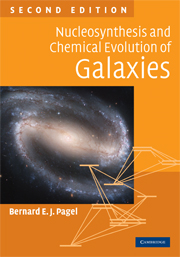Book contents
- Frontmatter
- Contents
- List of abbreviations
- Preface to the first edition
- Preface to the second edition
- 1 Introduction and overview
- 2 Thermonuclear reactions
- 3 Cosmic abundances of elements and isotopes
- 4 Cosmological nucleosynthesis and abundances of light elements
- 5 Outline of stellar structure and evolution
- 6 Neutron capture processes
- 7 Galactic chemical evolution: basic concepts and issues
- 8 Some specific GCE models and related observational data
- 9 Origin and evolution of light elements
- 10 Radioactive cosmochronology
- 11 Chemical evolution in other sorts of galaxies
- 12 Cosmic chemical evolution and diffuse background radiation
- Appendix 1 Some historical landmarks
- Appendix 2 Some physical and astronomical constants
- Appendix 3 Time-dependent perturbation theory and transition probabilities
- Appendix 4 Polytropic stellar models
- Appendix 5 Dissipation and abundance gradients
- Appendix 6 Hints for problems
- References
- Index
Preface to the second edition
Published online by Cambridge University Press: 05 June 2012
- Frontmatter
- Contents
- List of abbreviations
- Preface to the first edition
- Preface to the second edition
- 1 Introduction and overview
- 2 Thermonuclear reactions
- 3 Cosmic abundances of elements and isotopes
- 4 Cosmological nucleosynthesis and abundances of light elements
- 5 Outline of stellar structure and evolution
- 6 Neutron capture processes
- 7 Galactic chemical evolution: basic concepts and issues
- 8 Some specific GCE models and related observational data
- 9 Origin and evolution of light elements
- 10 Radioactive cosmochronology
- 11 Chemical evolution in other sorts of galaxies
- 12 Cosmic chemical evolution and diffuse background radiation
- Appendix 1 Some historical landmarks
- Appendix 2 Some physical and astronomical constants
- Appendix 3 Time-dependent perturbation theory and transition probabilities
- Appendix 4 Polytropic stellar models
- Appendix 5 Dissipation and abundance gradients
- Appendix 6 Hints for problems
- References
- Index
Summary
Much has happened since the book first came out in 1997. Cosmology has been transformed by balloon and satellite studies of the microwave background and by studies of distant supernovae. Host galaxies of γ-ray burst sources have been identified and some of their properties revealed. Cosmological simulations have been very successful in accounting for the large-scale structure of the Universe, although they are still challenged by observed element:element ratios suggesting that the largest galaxies were formed rapidly a long time ago, limiting the time available for their formation by mergers. The coming of 10-metre class telescopes, supplementing the Hubble Space Telescope, has led to enormous advances in abundance determinations in stars of all kinds and in galaxies, notably at high redshifts. Some stellar atmospheres can now be modelled by ab initio hydrodynamical simulations which account for granulation and eliminate the need for ad hoc parameters describing ‘macro-turbulence’ and ‘micro-turbulence’, leading to increasingly sophisticated abundance determinations. Nevertheless, simple analytical treatments retain their usefulness because of the insight they provide into the essential ingredients of more elaborate numerical models, whether of stellar atmospheres or of galactic chemical evolution.
I thank Monica Grady, Chris Tout and Max Pettini for critically reading through the revised Chapters 3, 5 and 12 respectively, and Mike Edmunds for continued cooperation and enlightening discussions. I owe particular thanks to my wife Annabel Tuby Pagel for her loving care during difficult times.
- Type
- Chapter
- Information
- Nucleosynthesis and Chemical Evolution of Galaxies , pp. xvii - xviiiPublisher: Cambridge University PressPrint publication year: 2009



